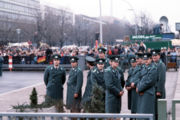German reunification
2008/9 Schools Wikipedia Selection. Related subjects: Recent History
![The division of Germany in 1949. The future West Germany (blue) consists of the American, British and French Zones (without the Saarland [purple], which later joined West Germany after a referendum), while East Germany (red) is formed from the Soviet Zone (without the western sections of Berlin [yellow]).](../../images/479/47990.png)
German reunification (German: Deutsche Wiedervereinigung) took place on 3 October 1990 when the five established states of the German Democratic Republic (GDR / East Germany) joined the Federal Republic of Germany (FRG / West Germany), and Berlin was united into a single city-state. The start of this reunification process is commonly referred to as die Wende (The Turning Point.).
After the GDR's first free elections on 18 March 1990, negotiations between the GDR and FRG culminated in a Unification Treaty, whilst negotiations between the GDR and FRG and the four occupying powers produced the so-called " Two Plus Four Treaty" granting full sovereignty to a unified German state, whose two halves had previously still been bound by a number of limitations stemming from its post-WWII-status as an occupied nation.
The reunified Germany remained a member of the European Community (later the European Union) and of NATO.
Naming
There is debate as to whether the events of 1990 should be properly referred to as a "reunification" or a "unification". Proponents of the former use the term in contrast with the initial unification of Germany in 1871. Popular parlance, which uses "reunification", is deeply affected by the 1989 opening of the Berlin Wall (and the rest of the inner German border) and the physical reunification of the city of Berlin (itself divided only since 1945). Others, however, argue that 1990 represented a "unification" of two German states into a larger entity which, in its resulting form, had never before existed (see History of Germany). For political and diplomatic reasons, West German politicians carefully avoided the term "reunification" during the run-up to what Germans frequently refer to as die Wende. The most common term in German is "Deutsche Einheit" or "German unity"; German unity is the term that Hans-Dietrich Genscher used in front of international journalists to correct them when they asked him about "reunification" in 1990.
After 1990, the term "die Wende" became more common. The term generally refers to the events (mostly in Eastern Europe) that led up to the actual reunification; in its usual context, this term loosely translates to "the turning point", without any further meaning. When referring to the events surrounding unification, however, it carries the cultural connotation of the time and the events in the GDR that brought about this "turnaround" in German history.
Reunification
History

Germany was officially reunified at 00:00 CET on 3 October 1990, when the five reestablished federal states ( Bundesländer) of East Germany— Brandenburg, Mecklenburg-Vorpommern, Saxony, Saxony-Anhalt, Thuringia—formally joined the Federal Republic of Germany, along with the city-state Berlin which formally came into being at the same time, created out of the still formally occupied West Berlin and East Berlin, and admitted to the federation. In practice however, West Berlin had already acted as an 11th state for most purposes, so Berlin is generally not included in the list of " New Länder".
The process chosen was one of two options implemented in the West German constitution ( Grundgesetz). As these five newly-founded German states formally joined the Federal Republic in accordance with (the then-existing) Article 23, the area in which the constitution served as the constitution was simply extended to include them. The alternative would have been for East Germany to join as a whole along the lines of a formal union between two German states that then would have had to, amongst other things, create a new constitution for the newly established country.
To facilitate this process and to reassure other countries, some changes were made to the " Basic Law" (constitution). Article 146 was amended so that Article 23 of the current constitution could be used for reunification. After the five "New Länder" of East Germany had joined, the constitution was amended again to indicate that all parts of Germany are now unified. Article 23 was rewritten as keeping it could be understood as an invitation to e.g. Austria to join. However, the constitution can be amended again at some future date and it still permits the adoption of another constitution by the German people at some time in the future.
On 14 November 1990, the German government signed a treaty with Poland, finalising Germany's boundaries as permanent along the Oder-Neisse line, and thus, renouncing any claims to Silesia, East Brandenburg, Farther Pomerania, Gdańsk (Danzig), and territories of the former province of East Prussia. The following month, the first all-German free elections since 1932 were held, resulting in an increased majority for the coalition government of Chancellor Helmut Kohl.
To commemorate the day that marks the official unification of the former East and West Germany in 1990, October 3rd has since then been the official German national holiday, the Day of German Unity (Tag der deutschen Einheit). It replaced the previous national holiday held in West Germany on June 17th commemorating the Uprising of 1953 in East Germany.